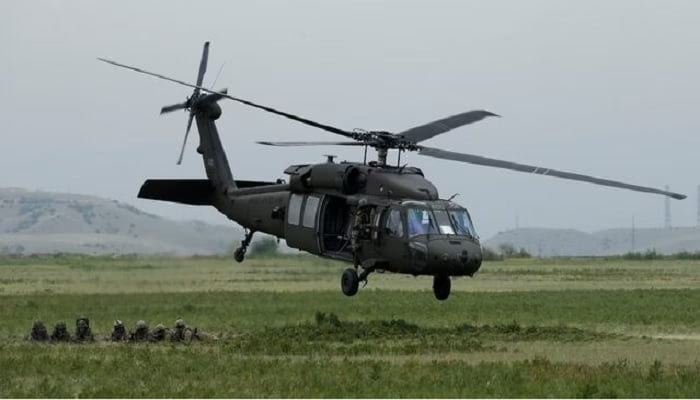A tragic incident occurred this week when a US Army Black Hawk helicopter crash claimed the lives of four special operations soldiers during a training exercise in Washington state. The soldiers, part of the elite 160th Special Operations Aviation Regiment, also known as the Night Stalkers, were conducting a routine nighttime drill near Joint Base Lewis-McChord when disaster struck.
Details of the US Army Black Hawk Helicopter Crash
The Sikorsky UH-60 Black Hawk went down at around 9 p.m. PDT on Wednesday in rugged terrain, approximately 15 miles southeast of Tacoma, Washington. According to the US Army Special Operations Command, the terrain was difficult to access, and recovery efforts were hampered by fire, dense vegetation, and the remote location of the crash site.
Jacqui Hill, spokesperson for the command, confirmed that no survivors were found among the four crew members. All belonged to the 4th Battalion of the 160th Special Operations Aviation Regiment, based at Joint Base Lewis-McChord.
The Legacy of the “Night Stalkers”
The US Army Black Hawk helicopter crash was particularly devastating because it involved members of the 160th SOAR, a unit famed for its expertise in nighttime operations. The “Night Stalkers” earned their name for pioneering the Army’s nighttime flying tactics and are often deployed in some of the world’s most dangerous missions.
These soldiers are among the best-trained aviators in the US military, regularly tasked with supporting special operations teams in high-risk combat zones. Their training includes mastering low-visibility conditions, which makes this accident even more shocking.
Lieutenant General Jonathan Braga, Commander of the US Army Special Operations Command, praised the fallen soldiers:
“They were elite warriors who embodied our highest values of the Army and the Army Special Operations, and their sacrifice will never be forgotten.”
Training Risks and Black Hawk Safety Record
The US Army Black Hawk helicopter crash raises questions about the risks of military training. While designed to simulate combat conditions, these exercises carry inherent dangers. Helicopter operations, especially in rugged or low-light environments, remain some of the most hazardous missions for military personnel.
The UH-60 Black Hawk has been a workhorse for the US Army since the late 1970s. It has served in multiple conflicts, from Iraq and Afghanistan to humanitarian missions worldwide. However, accidents are not uncommon. According to a Congressional Research Service report, between 2013 and 2020, more than 200 US military personnel lost their lives in aviation accidents during training and non-combat operations.
Recovery Efforts Following the Crash
Recovery operations following the US Army Black Hawk helicopter crash have proven challenging. Crews faced thick vegetation and crash-site fires that delayed access. By Friday, teams were still working to safely recover the remains of the soldiers and secure the site.
The Army has stated that an investigation is underway to determine the cause of the accident. Mechanical failure, human error, and environmental conditions are all being considered as potential factors.
Impact on Military Families and Community
The loss of four soldiers has left a deep mark on the military community at Joint Base Lewis-McChord and across the nation. Families of the fallen soldiers have been notified, though their names have not been officially released pending completion of the notification process.
Governor Jay Inslee of Washington called the accident “a heartbreaking reminder of the risks our service members face even in training,” and extended his condolences to the families.
Broader Context of Military Aviation Accidents
This US Army Black Hawk helicopter crash adds to a troubling pattern of aviation accidents in the US military. The National Commission on Military Aviation Safety reported in 2020 that non-combat aviation accidents cost the military 224 lives and $11.6 billion between 2013 and 2020. The commission called for stronger oversight, more funding for maintenance, and better pilot training to reduce risks.
While the Black Hawk is generally considered a reliable aircraft, incidents like this highlight the constant need for improvements in safety measures, particularly for units involved in demanding special operations training.
Honoring the Fallen
The soldiers lost in the US Army Black Hawk helicopter crash were not only aviators but elite warriors who dedicated their lives to protecting the nation. Their commitment to training, even in dangerous conditions, underscores the sacrifices made daily by service members.
Lieutenant General Braga’s tribute reflects the sentiments of many: their courage and service will remain an enduring legacy within the Night Stalkers and the US Army as a whole.
The US Army Black Hawk helicopter crash near Joint Base Lewis-McChord is a tragic reminder of the dangers inherent in military service, even outside combat zones. While investigations continue, the incident highlights the bravery of the 160th SOAR soldiers who gave their lives in service. As the nation mourns their loss, attention also turns to ensuring the safety of future training missions and reducing the risks faced by those who defend the country.



